Peanut Butter
The Perfect Peanut Butter and Jam Pairing Explained

Have you ever wondered why peanut butter and jam seem to go hand in hand, like two peas in a pod? The timeless combination of these two simple ingredients has intrigued and satisfied taste buds for generations.
But what is it about this classic duo that keeps us coming back for more? Join us as we explore the history, cultural significance, flavor harmony, and nutritional benefits of peanut butter and jam, and uncover the secrets behind this iconic pairing.
Key Takeaways
- The peanut butter and jelly sandwich has a rich history and cultural significance in American food culture, symbolizing comfort and home.
- Regional variations showcase the diversity of the sandwich, with different regions preferring different types of jelly and bread choices.
- Peanut butter and jam are versatile ingredients that can be used in a variety of dishes, from sauces and dressings to baked goods and smoothies.
- The combination of peanut butter and jam offers nutritional benefits, providing protein, healthy fats, essential vitamins, and minerals. However, it is important to consider portion control and choose healthier options.
History of Peanut Butter and Jam
The evolution of the peanut butter and jam combination showcases the culinary adaptation of traditional ingredients to the changing tastes and needs of society.
In 1901, the first recorded peanut butter and jelly sandwich recipe emerged, marking the beginning of a culinary phenomenon. Initially, peanut butter was paired with savory foods like cheese and celery before transitioning into a beloved sandwich spread.
The sandwich's popularity surged in the 1920s, coinciding with the availability of pre-sliced bread, making it more convenient for people to prepare. Notably, during World War II, peanut butter and jelly were included in US soldiers' military rations, further cementing the sandwich's popularity.
The combination of peanut butter and jelly became deeply ingrained in American culture, symbolizing comfort and home. This classic sandwich achieved widespread appeal among both adults and children, reflecting its versatility and widespread appeal.
The history of the peanut butter and jelly sandwich exemplifies the adaptability of culinary traditions to fit the needs and preferences of society, making it a timeless favorite.
Cultural Significance
The cultural significance of the peanut butter and jam sandwich lies in its rich history, regional variations, and its role as a symbol of childhood nostalgia.
This iconic combination of flavors has transcended class boundaries and economic hardship, becoming a unifying food choice enjoyed by generations.
Furthermore, the adaptability and enduring popularity of the PB&J sandwich reflect its continuous relevance and appeal in American food culture.
History of PB&J
Interestingly, the history of PB&J reveals its cultural significance and impact on American society. The peanut butter and jelly sandwich gained popularity in the 1920s, coinciding with the availability of sliced bread, making it a convenient meal option. Its inclusion in US soldiers' rations during World War II further solidified its place in American culture. The affordability and availability of PB&J made it a staple during hard times, such as the Great Depression, bridging economic gaps and symbolizing home and nostalgia for many. Notably, the sandwich's decline in the 1990s reflects larger societal changes, including concerns about processed foods and allergies. The Boston Cooking School Magazine's endorsement of the PB&J recipe in 1901 also contributed to its widespread popularity. Below is a table illustrating the historical timeline of peanut butter and jelly's cultural significance.
| Year | Event |
|---|---|
| 1920s | PB&J sandwich gains popularity due to sliced bread availability |
| World War II | Included in US soldiers' rations, contributing to widespread familiarity |
| Great Depression | Becomes a staple due to affordability and availability |
| 1990s | Decline in popularity mirrors societal changes and health concerns |
Regional Variations
Reflecting the diverse regional food preferences and culinary traditions, the peanut butter and jam sandwich exhibits cultural significance through its unique variations across different geographical areas.
In the United States, regional variations of the classic peanut butter and jelly sandwich abound. From the East Coast's preference for using strawberry jam to the Midwest's fondness for grape jelly, each region has its distinctive take on this beloved sandwich.
In the South, it's not uncommon to find peanut butter and jelly sandwiches served with a side of pickles, adding a sweet and tangy dimension. Additionally, variations in bread choices, such as white, wheat, or even cornbread, further illustrate the diverse culinary landscape.
These regional adaptations not only showcase the influence of local ingredients and flavors but also highlight the deep connection between food and cultural identity within different communities across the country.
Childhood Nostalgia
Indulging in a peanut butter and jelly sandwich often evokes a sense of childhood nostalgia, reminiscent of carefree days and simple pleasures. The classic PB&J sandwich holds a special place in the hearts of many, symbolizing comfort and familiarity. Here's a table to depict the emotional connection to the PB&J sandwich:
| Emotion | Description |
|---|---|
| Comfort | Feeling of security |
| Nostalgia | Remembrance of the past |
| Happiness | Joyful and carefree |
| Simplicity | Uncomplicated and easy |
| Connection | Bridging generations |
The sandwich's popularity during tough historical periods solidified its status as a cultural icon, spanning generations and evoking a sense of togetherness. Despite evolving food trends, the enduring love for this beloved sandwich showcases its timeless appeal and its ability to bring people together through shared memories of childhood.
Flavor Harmony
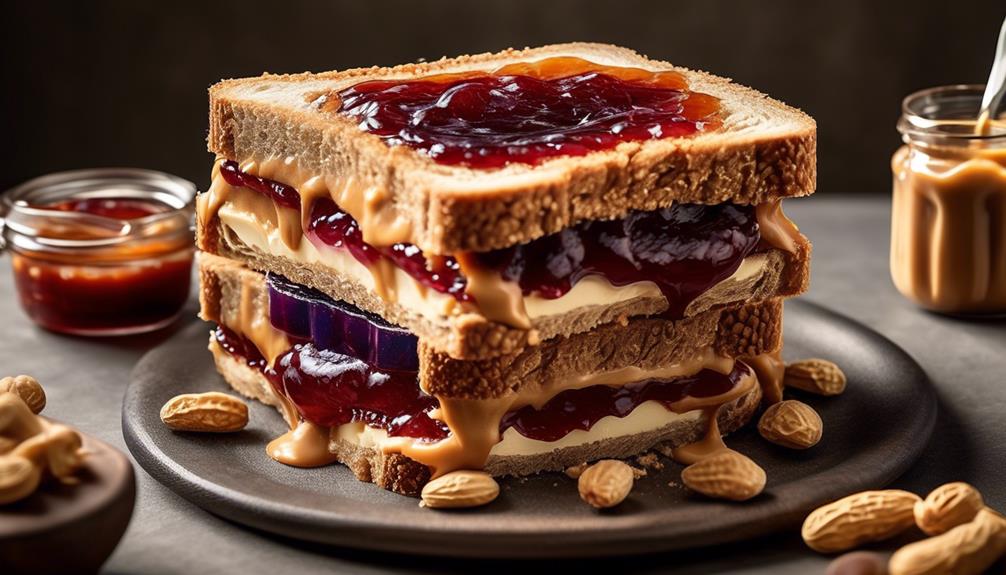
When it comes to flavor harmony, it's all about achieving the perfect balance of sweet, tangy, and nutty notes in a peanut butter and jam sandwich.
The creamy texture of peanut butter pairs seamlessly with the fruity sweetness of jam, creating a complementary taste profile that satisfies the palate.
From experimenting with different jam varieties to adding a hint of honey or a sprinkle of cinnamon, there are numerous ways to enhance the balanced sweetness and nuttiness of this classic combination.
Perfect Flavor Pairing
Certainly!
We consistently find that the combination of peanut butter and jam creates a perfect flavor pairing, achieving a delightful harmony of tastes. The popularity of peanut butter and jelly sandwiches is a testament to this. When spread on bread, the flavors of the peanut butter and jelly complement each other in a way that's both familiar and satisfying.
The origins of the peanut butter and jelly sandwich appeared in the early 20th century, and since then, it has become a staple in many households. The nuttiness of the peanut butter and the sweet, fruity notes of the jam create a balanced flavor profile that appeals to a wide audience.
This perfect pairing isn't only delicious but also versatile, making it suitable for any time of day.
Complementary Taste Profiles
Transitioning from the discussion of the perfect flavor pairing of peanut butter and jam, we now explore the concept of complementary taste profiles, focusing on the harmonious blend of contrasting flavors to create a balanced and pleasing combination.
The rich, savory notes of peanut butter are complemented by the bright, fruity sweetness of jam, creating a satisfying blend of flavors.
Contrasting textures of creamy peanut butter and chunky fruit preserves enhance the overall mouthfeel, adding depth to the eating experience.
Experimenting with different nut butters and fruit preserves can lead to new and delightful complementary taste profiles, expanding the flavor possibilities beyond the classic peanut butter and jam sandwiches.
Understanding complementary taste profiles can inspire creativity in combining various ingredients to create harmonious flavor experiences, contributing to a more enjoyable and diverse culinary journey.
Balanced Sweetness and Nuttiness
Achieving flavor harmony in a peanut butter and jelly sandwich involves balancing the sweetness of the jelly with the nuttiness of the peanut butter to create a well-rounded and satisfying flavor profile. When combining these two elements, the nuttiness of the peanut butter adds depth and richness to the overall sweetness of the jelly, resulting in a delightful culinary experience. Here's a helpful table to illustrate the balanced sweetness and nuttiness in a classic peanut butter and jelly sandwich recipe:
| Sweetness of Jelly | Nuttiness of Peanut Butter |
|---|---|
| Strawberry jam | Creamy peanut butter |
| Grape jelly | Chunky peanut butter |
| Raspberry preserves | Honey roasted peanut butter |
| Apricot jam | Almond butter |
The combination of sweet fruit preserves and savory peanut butter creates a harmonious and well-balanced flavor experience, making it a timeless favorite for many.
Nutritional Benefits

Peanut butter and jam offer a compelling combination of nutritional benefits that support overall health and well-being.
When considering the nutritional benefits of a peanut butter sandwich with jam, several factors come into play:
- Protein and Healthy Fats: Peanut butter provides a good source of protein and healthy fats, which can help keep you full and satisfied for longer periods.
- Essential Vitamins and Minerals: Jam contains essential vitamins and minerals from the fruit, contributing to your daily nutrient intake.
- Balanced Macronutrients: The combination of peanut butter and jam on whole grain bread offers a balanced mix of carbohydrates, fats, and proteins, making it a satisfying and energy-boosting meal or snack.
This classic combination not only offers a delightful taste but also provides a range of nutritional benefits.
Additionally, peanut butter is rich in vitamin E, magnesium, and potassium, contributing to overall heart health and muscle function.
Moreover, the convenience of this combination makes it a quick and easy way to obtain essential nutrients, making it an excellent option for those leading a busy lifestyle.
Versatility in Culinary Uses
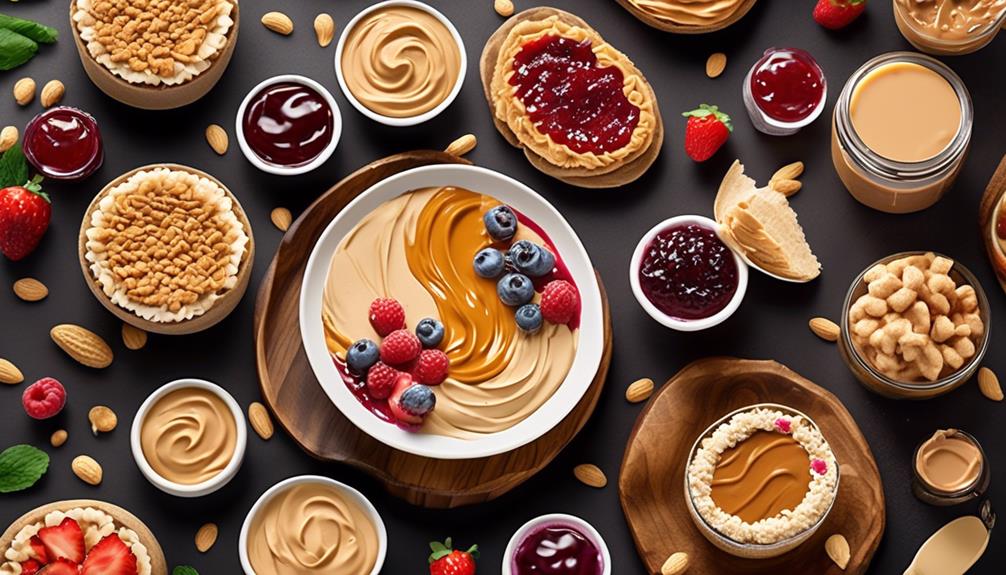
With its adaptable nature, peanut butter and jam can be utilized in a myriad of culinary applications, adding depth and flavor to a wide range of dishes.
Peanut butter's creamy texture and rich, nutty flavor make it a versatile ingredient in both sweet and savory dishes. It can be used as a base for sauces, dressings, and marinades, adding a depth of flavor to dishes like stir-fries, satays, and salad dressings.
In baking, peanut butter adds moisture and richness to cookies, cakes, and brownies, elevating the overall taste profile. Furthermore, peanut butter can be incorporated into smoothies, oatmeal, and yogurt, providing a protein-packed and satisfying addition to breakfast or snacks.
On the other hand, jam's sweet and fruity profile makes it a perfect complement to the nuttiness of peanut butter. Together, they create a classic combination that can be used in various culinary creations.
From classic PB&J sandwiches to being swirled into oatmeal, used as a topping for pancakes, or as a filling for pastries and desserts, the versatility of peanut butter and jam extends beyond the traditional sandwich. This culinary duo offers a harmonious blend of flavors that can enhance both sweet and savory dishes, making them a staple in the kitchen for adding depth and character to a wide array of recipes.
Evolution of Sandwich Culture
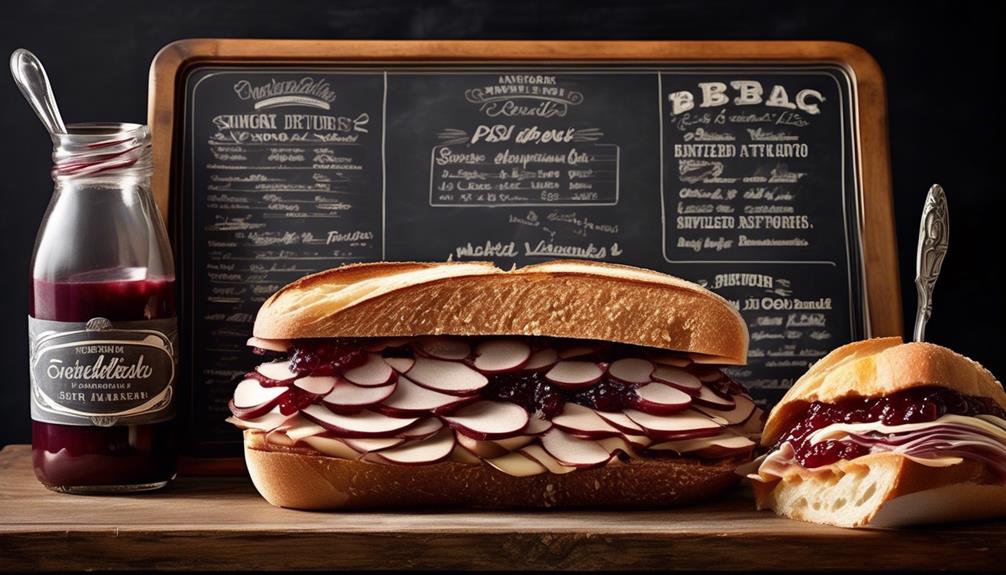
The evolution of sandwich culture has been influenced by various factors, including shifts in culinary preferences and socio-economic dynamics.
The history of the Goober, particularly the peanut butter and jelly sandwich, has played a pivotal role in shaping the evolution of sandwich culture. Here are some key points to consider:
- Historical Significance: The introduction of the peanut butter and jelly sandwich during the Great Depression and World War II not only provided sustenance but also became a symbol of resilience and resourcefulness during challenging times. This historical context has contributed to the enduring popularity and cultural significance of the PB&J sandwich.
- Culinary Innovation: The evolution of sandwich culture can be attributed to the creative variations of the classic PB&J. The use of different nut butters, spreads, and bread types has transformed the sandwich into a versatile culinary delight, reflecting the evolving tastes and preferences of consumers.
- Socio-Economic Impact: The accessibility of pre-sliced bread and the rise of industrialization significantly influenced the mainstream appeal of the PB&J sandwich. Its transition from an elite delicacy to a staple food highlights the intersection of cultural and economic dynamics in shaping the evolution of sandwich culture.
The peanut butter and jelly sandwich, with its rich history and cultural significance, continues to be a beloved icon in the evolving tapestry of sandwich culture.
Global Popularity
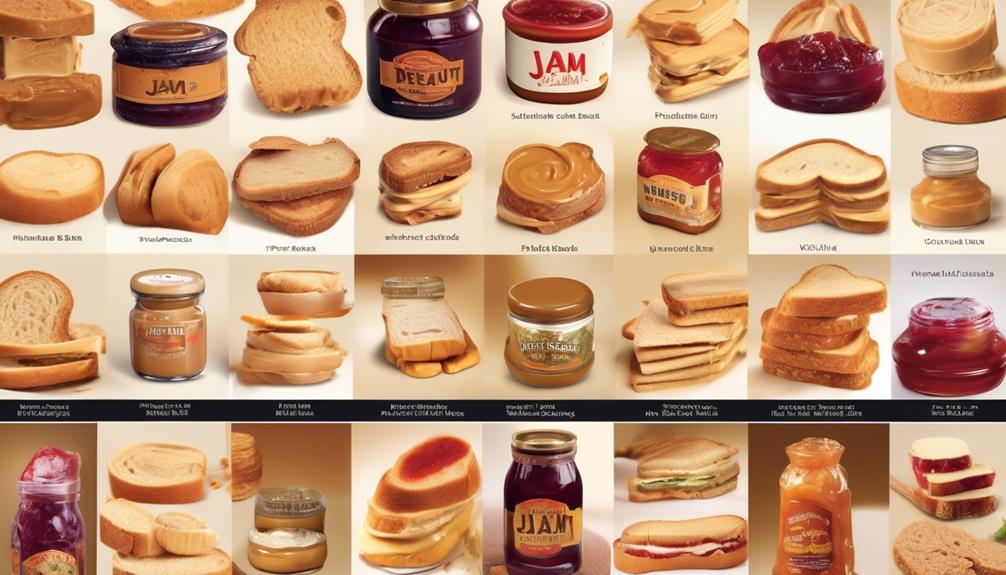
The widespread presence of the peanut butter and jelly sandwich in various global culinary landscapes underscores its enduring appeal and integration into diverse cultural contexts.
The peanut butter and jelly sandwich, often referred to as the 'PB&J' in the United States and as the 'peanut butter and jam sandwich' in the United Kingdom, has become a staple in many households across the globe. While it's undeniably America's favorite, its popularity extends beyond North America. In countries like Sweden and the Netherlands, variations of this beloved sandwich can be found, demonstrating its global reach.
The global popularity of the peanut butter and jelly sandwich reflects its status as a beloved comfort food with widespread appeal. Its incorporation into various cuisines and culinary creations worldwide further illustrates its influence on global food culture.
This international adoption of the peanut butter and jelly sandwich highlights its ability to transcend cultural boundaries and become a cherished part of diverse culinary traditions. Its adaptability and universal appeal have firmly established it as a timeless classic in the global culinary landscape.
Marketing and Advertising Impact

The global popularity of the peanut butter and jelly sandwich has undoubtedly been influenced by its marketing and advertising impact, which has played a significant role in reinforcing its status as a beloved comfort food with widespread appeal.
- Cultural Icon: The marketing and advertising efforts have transformed the peanut butter and jelly sandwich into a cultural icon, deeply ingrained in the collective consciousness of consumers. From nostalgic commercials to strategic product placements, the visibility of this classic combination has been strategically heightened.
- Brand Loyalty: Through targeted advertising campaigns, commercial peanut butter and jelly brands have successfully cultivated a sense of brand loyalty among consumers. These efforts haven't only increased sales but also strengthened the emotional connection individuals have with their preferred peanut butter and jelly products.
- Innovation and Diversification: Marketing initiatives have also driven innovation within the peanut butter and jelly industry, leading to the introduction of diverse product variations and spin-offs. These creative advertising strategies have expanded the appeal of peanut butter and jelly to new demographics and consumer segments.
The marketing and advertising impact has undeniably played a pivotal role in shaping the widespread adoration and enduring legacy of the peanut butter and jelly sandwich.
Psychological Appeal
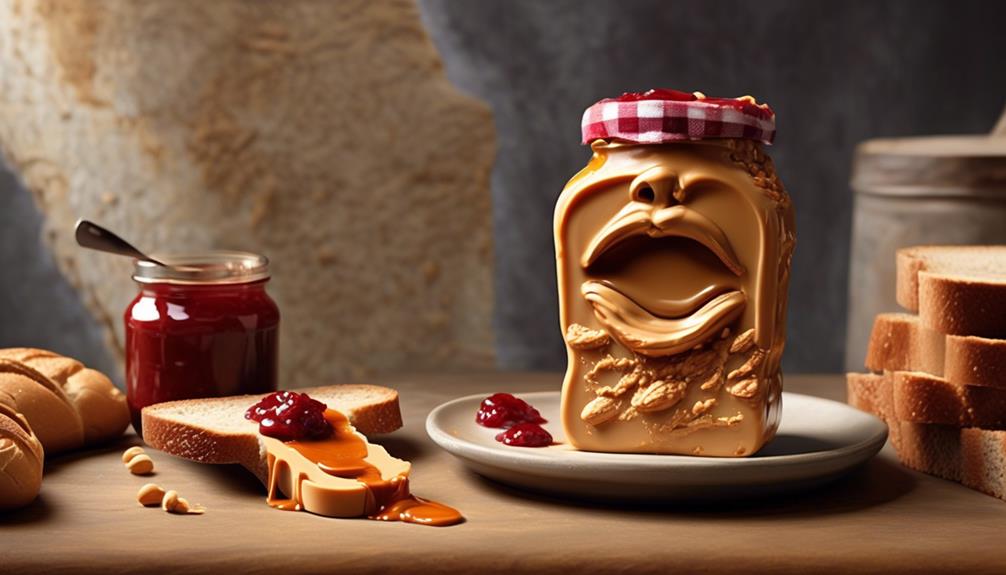
The flavor combination of peanut butter and jam has a powerful psychological appeal that resonates with many people.
The sweet and savory mix taps into childhood nostalgia, evoking feelings of comfort and happiness.
This psychological connection often leads to a strong emotional attachment to this classic pairing, making it a compelling choice for marketing and advertising campaigns.
Flavor Combination
Pairing certain flavors together can evoke strong emotional responses and positive associations, and the combination of peanut butter and jam exemplifies this psychological appeal.
- The sweet and salty contrast in peanut butter and jam creates a sensory experience that's both satisfying and familiar, contributing to its psychological appeal.
- This contrast triggers the brain's pleasure centers, leading to a sense of comfort and contentment.
The familiarity and nostalgia associated with peanut butter and jam can provide a sense of comfort and emotional well-being, making it a popular and enduring flavor combination.
- The psychological appeal of the peanut butter and jam flavor combination can evoke feelings of happiness, contentment, and a sense of home, making it a beloved choice for many.
The quintessential American flavor combination of peanut butter and jelly strikes a chord with many due to its ability to evoke strong emotional responses and positive associations.
Childhood Nostalgia
Flavor combinations like peanut butter and jam evoke strong emotional responses, and the psychological appeal of childhood nostalgia further enhances the positive associations with these familiar foods.
Childhood nostalgia plays a significant role in shaping our preference for peanut butter and jelly sandwiches, often linked to memories of school lunches and after-school snacks. The comfort and security provided by these classic sandwiches create a psychological connection to our early years, evoking feelings of happiness and warmth.
Revisiting these childhood foods offers a sense of continuity and emotional significance, fostering a deep connection to our past. This psychological appeal not only influences personal food preferences but also contributes to cultural and societal traditions, contributing to the enduring popularity of the beloved peanut butter and jam sandwich.
Culinary Pairing Science

Exploring the intricate science of culinary pairing allows us to understand the complex interactions between different food components and create harmonious, well-balanced combinations that enhance the overall dining experience. Culinary pairing science involves a deep understanding of flavor interactions, considering factors such as taste, texture, aroma, and appearance to create balanced and complementary pairings.
This science also delves into the chemical reactions and sensory perceptions that occur when different foods are combined, leading to a deeper understanding of flavor dynamics. By studying culinary pairing science, individuals can elevate their cooking skills, leading to the creation of well-balanced and delicious dishes.
Understanding Flavor Interactions:
- Exploring how different flavors complement or contrast with each other, such as the sweet and salty combination in peanut butter and jelly sandwiches.
Chemical Reactions and Sensory Perception:
- Investigating how ingredients interact on a molecular level, affecting taste, texture, and overall eating experience.
Creative and Innovative Combinations:
- Utilizing culinary science to experiment with unique and unexpected pairings, enhancing the dining experience for food enthusiasts.
Incorporating the principles of culinary science can lead to the creation of delightful and memorable food pairings, such as the timeless combination of peanut butter and jam.
Art of Spreading

When it comes to the art of spreading peanut butter and jam, the technique is crucial in achieving a well-balanced flavor profile.
Ensuring even coverage to the edges of the bread allows for a consistent taste in every bite.
Additionally, experimenting with different textures and consistencies can elevate the overall experience of the sandwich.
Spreading Techniques
Using a smooth and consistent motion, spread the peanut butter evenly across the bread to ensure a balanced distribution of flavor and texture. When it comes to spreading techniques for the perfect peanut butter and jelly sandwich, it's essential to consider the following:
- Pressure: Apply gentle pressure while spreading to avoid tearing the bread and ensure an even layer of peanut butter.
- *Tip*: Use a butter knife or offset spatula for better control and precision.
- Temperature: For smooth spreading, consider warming the peanut butter slightly to make it more pliable.
- *Tip*: Place the sealed peanut butter jar in warm water for a few minutes before spreading.
- Manufacturing: Understanding the manufacturing process of peanut butter can provide insights into its spreadability and texture variations.
- *Tip*: Look for natural peanut butter options with no added oils or sugars for a more authentic taste and texture.
Flavor Combinations
After mastering the spreading techniques for the perfect peanut butter and jelly sandwich, the next step is to explore the art of flavor combinations to elevate the overall taste experience. By experimenting with variations such as honey, sliced fruit, marshmallow fluff, or almond butter, one can create a unique and flavorful spread. These additions not only enhance the taste but also offer nutritional benefits.
Understanding the history of peanut butter and jelly sandwiches, including their rise in popularity during the 1920s and their inclusion in U.S. soldiers' rations in World War II, provides context to the art of spreading. The cultural significance of the sandwich, from becoming a staple during hard times to its decline in popularity in the 1990s, offers insight into its enduring appeal and the endless possibilities for flavor combinations.
Texture and Consistency
To achieve the ideal texture and consistency when spreading peanut butter and jelly, it's essential to consider the thickness of the bread and the evenness of the spread, ensuring a balanced and satisfying mouthfeel with each bite.
When it comes to the art of spreading peanut butter and jelly on bread, the following factors play a crucial role:
- Bread Thickness
Thin slices of bread may not support a heavy layer of spread, potentially leading to a soggy or messy sandwich.
Thick slices of bread can accommodate a generous spread of peanut butter and jelly while maintaining structural integrity.
- Evenness of Spread
Uneven spreading can result in pockets of intense flavor alongside areas with minimal spread, impacting the overall taste experience.
Consistent and thorough spreading ensures a harmonious integration of peanut butter and jelly flavors in every bite.
- Mouthfeel
Achieving the perfect texture and consistency guarantees a delightful and gratifying sensation with each bite of the peanut butter and jelly sandwich.
Iconic Pair in Literature and Media
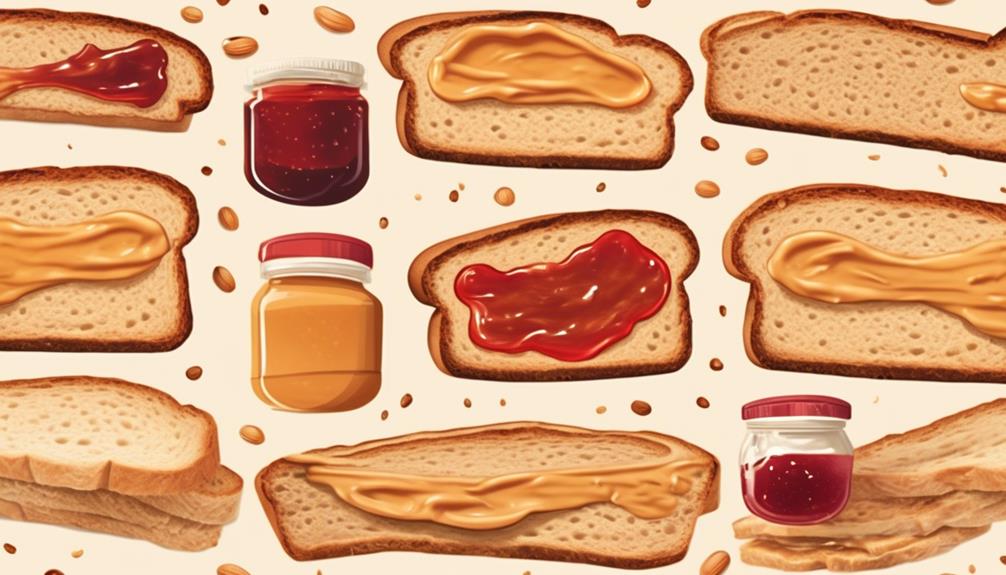
The iconic pairing of peanut butter and jam has permeated literature and media, becoming a timeless symbol of comfort and simplicity. In literature, this classic duo has been used to evoke nostalgia, innocence, and the simple pleasures of life. From children's books to literary classics, references to the peanut butter and jelly sandwich abound, creating a sense of relatability and warmth for readers. In media, this iconic pair has been featured in countless films, TV shows, and advertisements, often symbolizing the bond between characters or the familiarity of home. The enduring presence of the peanut butter and jam sandwich in literature and media speaks to its status as a cultural touchstone, representing not only a delicious snack but also a powerful symbol of togetherness and enduring simplicity.
| Literature | Media |
|---|---|
| References to PB&J in | PB&J used as a symbol of |
| books, poems, and stories | bonding, comfort, and |
| across various genres | nostalgia in films, TV |
| shows, and advertisements |
Health Considerations
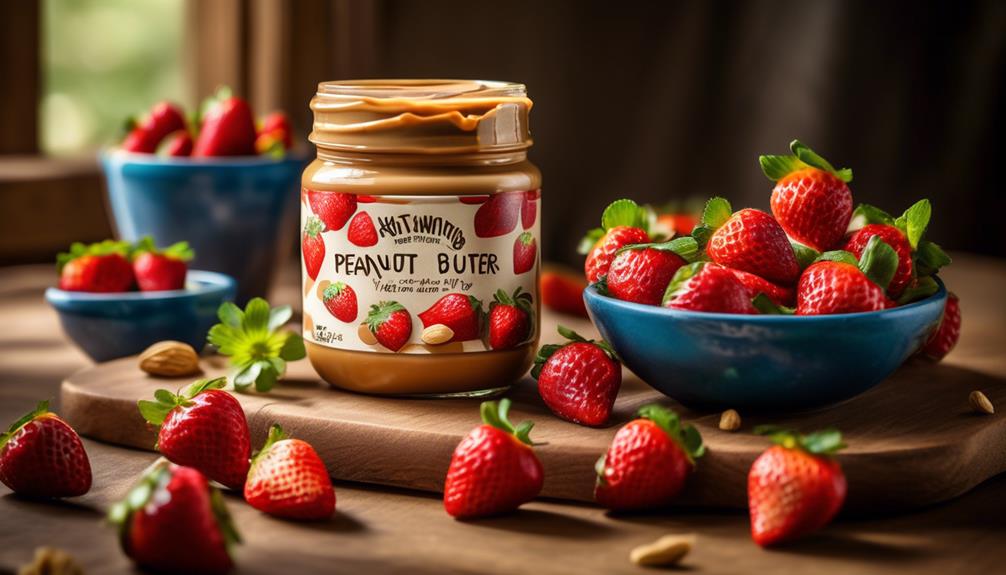
Consider watching portion sizes when consuming the classic peanut butter and jam sandwich, as it can be calorie-dense. When indulging in this beloved combination, it's important to be mindful of the overall caloric intake, especially for those watching their weight.
To make this iconic sandwich a bit healthier, one could opt for whole grain bread, which provides added fiber and nutrients, contributing to a more balanced meal. Additionally, choosing natural peanut butter without added sugars or oils reduces the intake of unnecessary additives, aligning with the recommendations of the National Peanut Board.
Another health-conscious choice is to use lower sugar or sugar-free fruit preserves or spreads to lessen the overall sugar content of the sandwich. By making these simple adjustments, one can enjoy the classic pairing while being more health-conscious.
It's also crucial to consider potential allergies, particularly nut allergies, and to be sensitive to dietary restrictions by offering suitable alternatives. Overall, being mindful of these health considerations allows individuals to savor the timeless delight of peanut butter and jam while maintaining a balanced diet.
Future of PB&J

Looking ahead to the future of PB&J, innovative variations using different types of nut butters and alternative spreads like cream cheese or Nutella are likely to become more prominent. The classic peanut butter and jelly sandwich may see a culinary evolution as creative additions such as honey, sliced fruit, or marshmallow fluff are incorporated for unique flavor profiles.
In fact, with the growing interest in gourmet foods, the future of PB&J could also involve gourmet versions and PB&J-inspired desserts and snacks. Chefs and food enthusiasts are expected to explore new ways to enjoy this timeless combination, expanding its potential beyond the traditional sandwich.
Moreover, as societal and dietary preferences change, the future of PB&J may lean towards healthier and sustainable options, potentially incorporating gluten-free bread or organic, natural nut butters and fruit preserves.
With advancements in food technology and meal delivery services, the future of PB&J may also involve convenient, ready-to-assemble kits or innovative cooking tricks to enhance the overall experience of preparing and enjoying a PB&J sandwich.
The possibilities are endless as we reimagine the future of this beloved culinary creation.
Frequently Asked Questions
Why Do Americans Eat Peanut Butter and Jam?
We eat peanut butter and jam because it's a convenient, beloved meal option. It gained popularity during the Great Depression and was included in soldiers' rations during World War II.
This sandwich provides significant calories, fats, carbohydrates, and proteins, making it a substantial and filling meal. It's a symbol of home, enjoyed by both adults and children, and bridges economic gaps in our society.
Despite changes in food trends, it remains a favorite, offering nostalgia and comfort.
Why Is Peanut Butter and Jelly so Good Together?
We find peanut butter and jelly so good together because the creamy, nutty peanut butter perfectly complements the sweet, tangy jelly. The combination creates a satisfying mouthfeel and a delightful flavor contrast.
Additionally, it provides a good balance of protein, healthy fats, and carbohydrates, making it a satisfying and nourishing snack or meal.
The nostalgic and comforting association of peanut butter and jelly sandwiches further adds to its appeal for people of all ages.
Why Was the Peanut Butter and Jelly Sandwich Invented?
The peanut butter and jelly sandwich was invented as a convenient, tasty meal option. It became popular due to its association with childhood and nostalgia, as well as being part of US soldiers' rations during World War II.
Initially considered an upper-class treat, it became a staple during hard times like the Great Depression. Today, there are variations using different nut butters, alternative spreads, and creative additions like fruits or marshmallow fluff.
What Does the Peanut Butter and Jelly Symbolize?
Peanut butter and jelly symbolize comfort, simplicity, and inclusivity. It represents a nostalgic and affordable food choice, enjoyed across generations.
This classic combination reflects the adaptability and cultural fusion of food, evolving to include various ingredients and variations. Its popularity during economic hardship showcases its accessibility and appeal to people from all walks of life.
Conclusion
In conclusion, the timeless combination of peanut butter and jam has a rich history, cultural significance, and nutritional benefits. Its flavor harmony and versatility in culinary uses make it a beloved favorite.
The art of spreading and its iconic presence in literature and media further solidify its place in our hearts and stomachs.
As we consider the future of PB&J, we can't help but wonder: can any other sandwich truly compare?
From sneaky childhood butter licks to penning some of our most popular articles, Jamie’s journey with butter has been lifelong. His culinary background gives him a unique perspective, allowing him to craft mouthwatering articles that educate and tantalize equally. Jamie’s travel adventures revolve around finding the world’s best buttery treats when he isn’t writing.
Peanut Butter
What Makes Peanut Butter Whiskey Unique?

So, you're curious about peanut butter whiskey? Well, it's certainly an intriguing concept, isn't it?
The idea of blending the rich, nutty flavor of peanut butter with the warmth of whiskey is something that piques the interest of many.
But how does it actually taste? Is it a gimmicky novelty or a genuinely enjoyable spirit?
Let's explore the world of peanut butter whiskey and uncover what makes it a standout in the realm of flavored spirits.
Key Takeaways
- Peanut butter whiskey offers a unique flavor profile, combining the rich, nutty taste of peanut butter with the smooth warmth of whiskey.
- It appeals to both whiskey enthusiasts and those with a sweet tooth, offering a velvety, nutty sweetness on the palate.
- With an initial aroma reminiscent of freshly ground peanuts, it provides a familiar and comforting warmth of whiskey on the finish.
- Peanut butter whiskey has gained popularity due to its exceptional taste, appealing to those who prefer sweeter alcohol options and expanding the flavored whiskey market in the United States.
Peanut Butter Whiskey: A Unique Flavor Profile
Peanut butter whiskey offers a unique flavor profile that combines the rich, nutty taste of peanut butter with the smooth warmth of whiskey, creating a distinctive and indulgent drinking experience.
The marriage of whiskey and peanut butter creates a surprisingly delightful fusion that appeals to both whiskey enthusiasts and those with a sweet tooth. This flavored whiskey introduces a whole new dimension to the world of spirits, challenging traditional notions of what whiskey can be.
The initial aroma is reminiscent of freshly ground peanuts, followed by a velvety, nutty sweetness on the palate, which then gives way to the familiar, comforting warmth of whiskey as it goes down. The interplay of these flavors creates a truly unique drinking experience that's both familiar and novel at the same time.
The balance between the distinct nuttiness and the classic whiskey notes is what sets peanut butter whiskey apart, making it an intriguing choice for those seeking a departure from conventional whiskey flavors.
Understanding the Alcohol Content
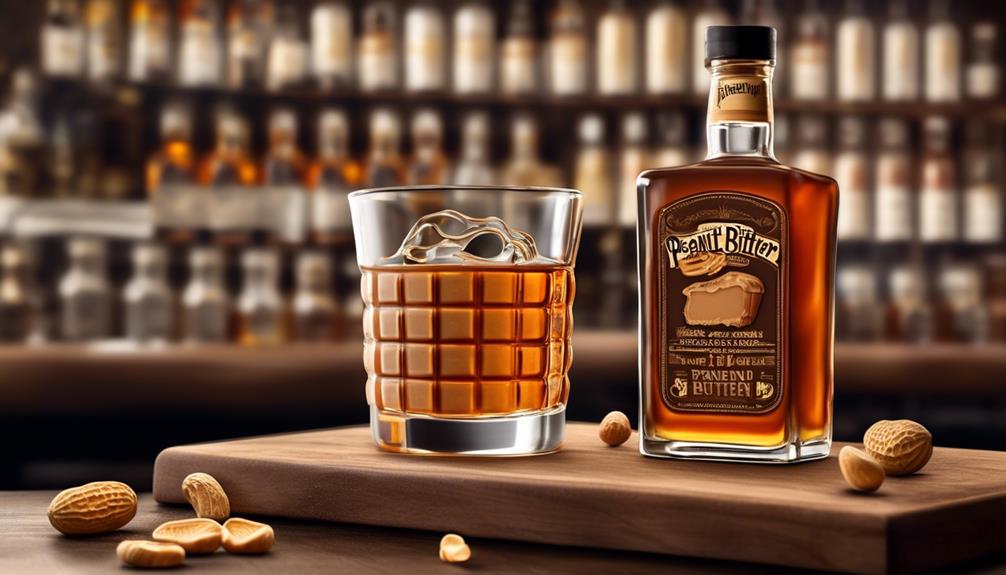
As we continue our exploration of peanut butter whiskey's unique qualities, it's important to understand the alcohol content of this distinct spirit and how it sets it apart from traditional whiskeys.
Unlike typical American whiskey, peanut butter whiskey is known for its lower alcohol percentage, ranging from 30 to 35%, approximately 70 proof, which is notably lower than traditional whiskey's 80 proof. While this places it outside the classification of Scotch whisky according to EU standards, peanut butter whiskey doesn't make such claims.
Despite its lower alcohol by volume (ABV), the whiskey flavored with peanut butter has gained popularity due to its exceptional taste, appealing particularly to those who prefer sweeter alcohol or who previously believed they didn't enjoy whiskey.
For those interested in understanding the alcohol content of different brands, Bartendr provides a comprehensive guide, offering a roundup of the most common peanut butter whiskey brands and their alcohol percentages. This knowledge is crucial for consumers to make informed decisions before purchasing or selecting serving sizes.
Understanding the distinctive alcohol content of peanut butter whiskey is essential to fully appreciate its unique qualities and make the most of this flavorful spirit.
Serving Suggestions and Pairings
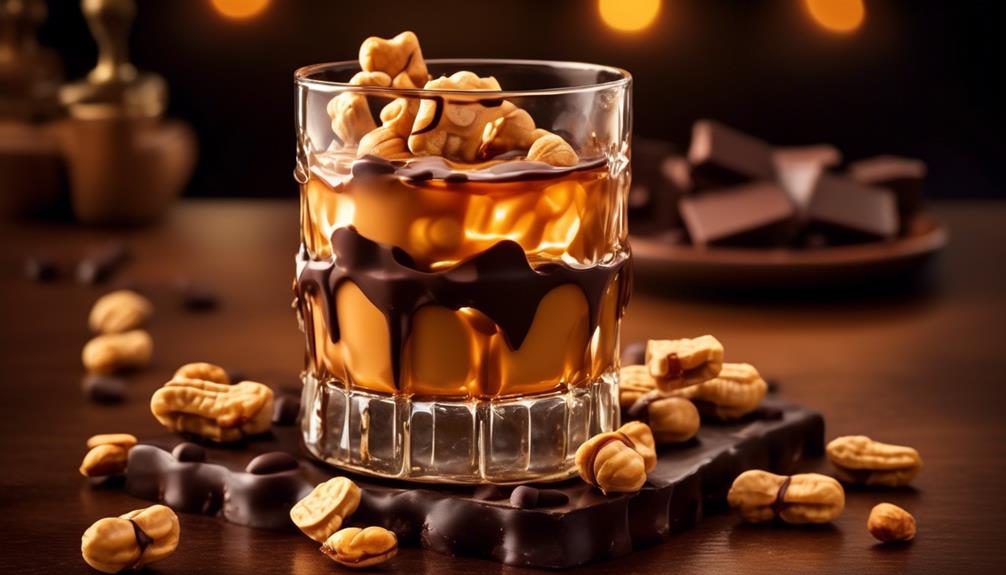
When considering serving suggestions and pairings for Skrewball Peanut Butter Whiskey, various options allow for a versatile and enjoyable drinking experience. Skrewball can be savored neat, on the rocks, or with a splash of water, enhancing its delightful aromatics and flavors.
Additionally, the whiskey can be paired with jammy cassis for a delightful enhancement of fruity flavors, or added to an old-fashioned cocktail for a nutty twist. For those seeking to experiment, mixing Skrewball with alcohols like RumChata, vanilla vodka, and caramel liqueur offers rich and complementary flavors.
Alternatively, trying it with coffee, Coca-Cola, apple cider, berry-flavored seltzer, or chocolate milk provides unique one-ingredient mixers. The versatility of Skrewball opens up new possibilities for whiskey enthusiasts to explore and enjoy creative cocktail combinations.
For further inspiration, the Skrewball website offers additional serving suggestions and cocktail recipes to elevate your next drink with this distinctive flavored whiskey. With these options, Skrewball Peanut Butter Whiskey promises an exciting and flavorful drinking experience.
Exploring Popular Peanut Butter Whiskey Brands

With the rise in popularity of flavored whiskies, a new category has emerged, introducing unique and unconventional flavors to the market. Among these, peanut butter whiskey has garnered significant attention. One of the most popular brands in this category is Skrewball Peanut Butter Whiskey, which has made a mark with its genuine peanut butter aroma and taste. This American whiskey flavored with peanut butter has gained a devoted following due to its unconventional yet enjoyable drinking experience. Created by Steven Yeng and his wife Brittany in San Diego, this flavored whiskey has experienced remarkable growth, evidenced by a staggering 1,976% increase in 2021 and its subsequent acquisition by drinks giant Pernod Ricard in 2023.
The rise of Skrewball Peanut Butter Whiskey also reflects the expanding flavored whiskey market in the United States, with major brands like Fireball, Jim Beam, and Jack Daniels venturing into this space. Skrewball, made with a base of corn and barley, infused with natural flavors, has become renowned for its refusal to provide extensive technical information, emphasizing its unique flavor profile. This versatile whiskey can be enjoyed on its own, mixed in cocktails, or paired with various flavors, offering a creative and adaptable drinking experience.
Making the Most of Skrewball Whiskey
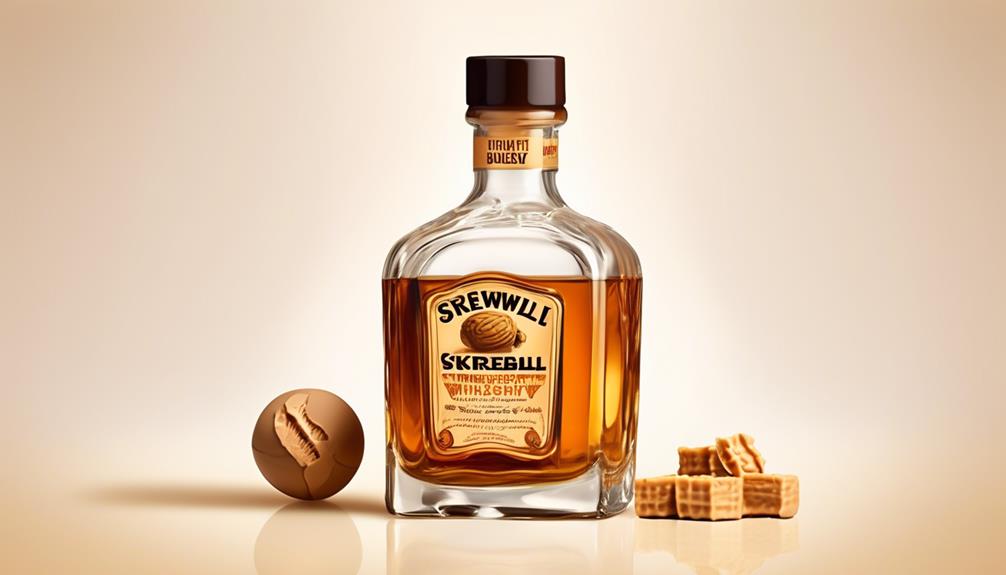
Exploring the versatility and unique flavor profile of Skrewball Peanut Butter Whiskey allows for a delightful and adaptable drinking experience, making it a standout choice in the flavored whiskey market. Skrewball isn't only a delightful sipping whiskey but also a versatile ingredient for crafting innovative cocktails.
Here's how to make the most of Skrewball Whiskey:
- Mixology Mastery: Experiment with Skrewball in classic cocktails like Old Fashioneds or create your own unique concoctions to elevate your mixology skills.
- Decadent Desserts: Infuse your desserts with the rich, nutty flavor of Skrewball, adding a delightful twist to your culinary creations.
- Liquor Store Finds: Seek out Skrewball at your local liquor store and explore the endless possibilities it offers for your home bar.
- Unconventional Pairings: Pair Skrewball with unexpected flavors like chocolate, banana, or even chili for an adventurous tasting experience.
- Whiskey-Flavored Adventures: Take your taste buds on a journey by incorporating Skrewball into your next whiskey tasting session, and savor its unique aroma and taste.
Skrewball Peanut Butter Whiskey opens up a world of flavor possibilities, perfect for those seeking a departure from traditional whiskey experiences.
Mixing and Cocktail Recipes
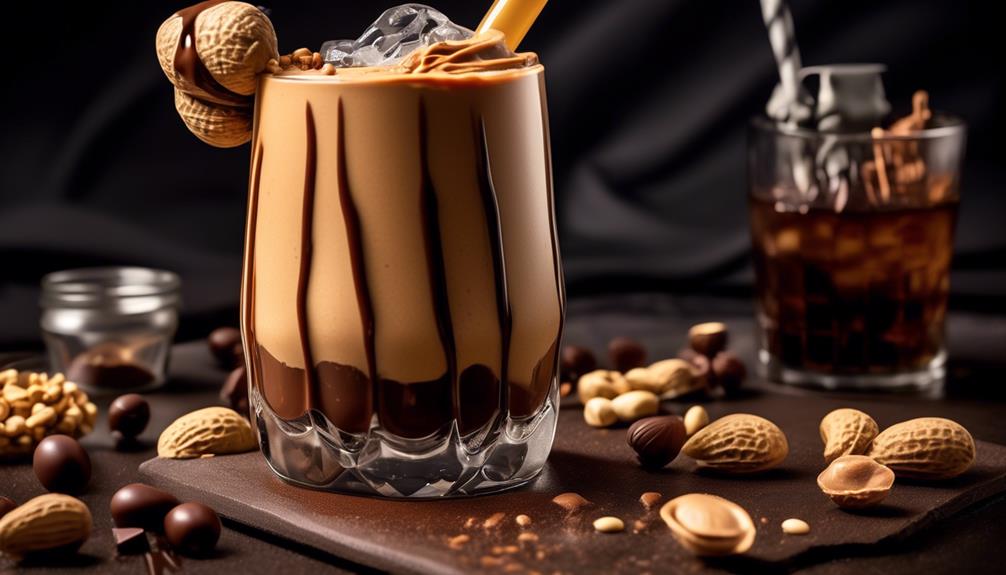
Let's dive into the art of mixing and crafting delectable cocktail recipes using Skrewball Peanut Butter Whiskey, adding a unique twist to traditional libations. Skrewball Peanut Butter Whiskey offers a delightful combination of whiskey flavored with the nutty richness of peanut butter, allowing for the creation of innovative cocktail recipes that tantalize the taste buds. Experimenting with mixing Skrewball with ingredients like jammy cassis, old-fashioned mixers, or complementary spirits such as RumChata and vanilla vodka can result in rich and distinct flavors. The versatility of Skrewball enables the crafting of unique cocktails, including the Graper Manhattan or the Peanut Butter and Honey Old-Fashioned (Winnie's Cup). When mixing Skrewball, it's crucial to consider its sweetness and balance it with other flavors to create well-rounded and enjoyable cocktails. For further inspiration, Skrewball's website offers a variety of well-balanced cocktail recipes, providing guidance for those looking to explore the distinct flavor profile of peanut butter whiskey in mixed drinks.
| Mixing Ideas | Cocktail Recipes |
|---|---|
| Jammy Cassis | Graper Manhattan |
| Old-Fashioned Mixers | Peanut Butter and Honey Old-Fashioned |
| Complementary Spirits (RumChata) | – |
Where to Find Peanut Butter Whiskey

We can easily find popular brands of peanut butter whiskey at our local liquor stores, such as Skrewball, Sheep Dog, and Ole Smoky.
If we prefer the convenience of online shopping, various retailers and alcohol delivery services offer peanut butter whiskey for purchase and delivery.
Additionally, Total Wine is a great option for those seeking a diverse selection of peanut butter whiskey, while specific venues like OB Noodle House Bar 1502 in San Diego may offer the original Skrewball peanut butter whiskey.
Popular Brands Available
Peanut butter whiskey has gained popularity in recent years, with several notable brands like Skrewball, Sheep Dog, and Ole Smoky entering the flavored whiskey market and becoming readily available at liquor stores across the U.S.
- Skrewball Peanut Butter Whiskey offers a genuine peanut butter aroma and taste, providing a unique drinking experience.
- The market has seen significant growth, with major brands like Skrewball, Sheep Dog, and Ole Smoky entering the flavored whiskey market.
- You can find peanut butter whiskey at practically any liquor store in the U.S. and online through retailers like Total Wine.
- Peanut butter whiskey typically has a lower alcohol percentage, around 30-35% ABV, making it sweeter and suitable for mixed drinks.
- Skrewball Peanut Butter Whiskey can be enjoyed alone, in cocktails, or paired with complementary flavors, offering new possibilities for whiskey enthusiasts.
Online and Local Stores
With the growing availability of peanut butter whiskey at both online and local liquor stores, enthusiasts can easily explore a wide range of popular brands such as Skrewball, Sheep Dog, and Sqrrl, as well as other lesser-known options. Check out the table below to discover where you can find these delectable bottles:
| Store | Online Availability | Physical Locations |
|---|---|---|
| Total Wine | Yes | Yes |
| OB Noodle House | No | Yes (San Diego) |
| Bartendr | Yes | No |
| Local Liquor Stores | Varies | Yes |
Peanut butter whiskey, a creation often likened to the nostalgic flavors of peanut butter and jelly, is now easily accessible for both online and in-store purchases. Whether you're seeking the original Skrewball peanut butter whiskey that's a San Diego specialty or looking to explore new flavors like raspberry liqueur-infused options, the options are plentiful. Steven Yeng's innovative fusion of whiskey and peanut butter has truly revolutionized the spirit market.
Specialty Liquor Shops
Exploring specialty liquor shops allows enthusiasts to discover a diverse selection of peanut butter whiskey brands and unique variations, offering a rich opportunity for expanding one's palate and exploring the world of flavored spirits. When seeking out peanut butter-flavored whiskey, specialty liquor shops are an ideal destination due to their distinct advantages:
- They often carry a range of peanut butter whiskey brands, including popular options like Skrewball, Sheep Dog, Ole Smoky, and Skatterbrain.
- Many offer online purchasing and delivery options for convenient access.
- Some stock exclusive or limited edition peanut butter whiskey variations.
- Knowledgeable staff can offer guidance on selection, serving suggestions, and cocktail recipes.
- Visiting provides an opportunity to explore other unique flavored spirits, expanding one's palate beyond peanut butter whiskey.
Frequently Asked Questions
Does Peanut Butter Whiskey Taste Good?
Tastes vary, but we find peanut butter whiskey to be surprisingly delicious. It offers a unique blend of genuine peanut butter flavor and a hint of whiskey bite, making it an enjoyable and versatile spirit.
Its boozy lift complements creative cocktail combinations, and the subtle buttery pastry notes add complexity. While it may not suit everyone's taste, it's a milder option at around 30 to 35% alcohol, making it appealing to those who prefer sweeter alcohol or thought they didn't like whiskey.
Can You Drink Peanut Butter Whiskey Straight?
Absolutely, you can drink peanut butter whiskey straight. The rich, nutty flavor of the whiskey shines through when sipped neat, creating a smooth and indulgent experience. It's a great way to fully appreciate the unique taste profile of the spirit.
The creamy texture and hints of roasted nuts make it a delightful choice for savoring on its own.
How Is Skrewball Peanut Butter Whiskey Made?
Skrewball Peanut Butter Whiskey is made with a blend of corn and barley, infused with natural flavors, giving it an authentic peanut butter taste and aroma. Details of its production, like age statement, aren't disclosed.
It's a versatile spirit, enjoyable on its own or in cocktails, offering a fun and unique flavor profile. It pairs well with flavors like cassis and chocolate, providing a nutty twist to classic cocktails.
Is Skrewball Actually Good?
Oh, Skrewball Peanut Butter Whiskey? It's a game-changer.
The genuine peanut butter flavor and aroma set it apart, making it a delightful surprise for the palate.
The smooth, versatile nature of Skrewball makes it great for sipping on its own or getting creative with cocktails.
Its popularity and market relevance speak volumes about its quality.
Trust us, it's a winner.
Conclusion
In a world full of traditional whiskeys, peanut butter whiskey stands out as a unique and flavorful option. Its rich and smooth taste, reminiscent of a childhood favorite, offers a nostalgic and comforting experience.
Just like spreading peanut butter on warm toast, peanut butter whiskey brings warmth and comfort to any occasion. It's a symbol of creativity and innovation in the world of spirits, and a must-try for anyone looking to add a twist to their whiskey collection.
From sneaky childhood butter licks to penning some of our most popular articles, Jamie’s journey with butter has been lifelong. His culinary background gives him a unique perspective, allowing him to craft mouthwatering articles that educate and tantalize equally. Jamie’s travel adventures revolve around finding the world’s best buttery treats when he isn’t writing.
Peanut Butter
Exploring Peanut Butter Price Trends: Factors Impacting Cost
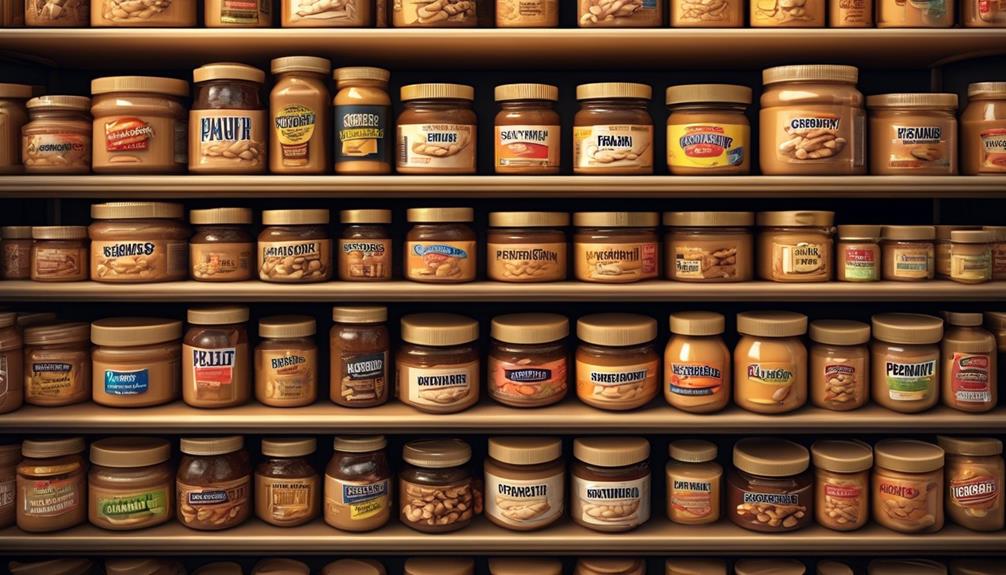
We've all experienced the sticker shock at the grocery store when we reach for our favorite jar of peanut butter, only to find that the price has increased yet again. It leaves us wondering, why is peanut butter so expensive?
Well, there are several factors at play that contribute to the price of this beloved spread. From the cost of peanuts themselves to the impact of market demand and branding, the reasons behind the price of peanut butter might surprise you.
Let's explore the various factors that make peanut butter price what it is and uncover the complexities behind this pantry staple.
Key Takeaways
- Adverse weather conditions and reduced peanut production are contributing factors to the increase in peanut butter pricing.
- High demand for peanut butter among health and fitness enthusiasts is driving up its price.
- Marketing efforts and branding strategies play a role in the higher pricing of peanut butter.
- Packaging and perceived value also impact the pricing of peanut butter.
Factors Affecting Peanut Butter Pricing
Experiencing a shortage due to sweltering temperatures and smaller crops, peanut butter pricing is being affected by various factors in the market.
The Peanut Belt states of Georgia and Texas, which usually yield substantial peanut crops, have been hit by adverse weather conditions, leading to a decrease in peanut production. This scarcity has a direct impact on peanut butter prices, as the reduced supply drives up costs for manufacturers. Companies such as J.M. Smucker Co. are already planning to raise prices in response to the smaller crop, further contributing to the increase in peanut butter pricing.
Additionally, the high demand for peanut butter, fueled by its popularity among health and fitness enthusiasts, as well as shifting consumer preferences, has played a significant role in driving up its cost. Furthermore, the marketing efforts and branding strategies employed by peanut butter companies to stand out in the competitive peanut butter market have also contributed to the higher pricing of peanut butter.
The cost of storing and handling peanuts, including additional expenses for proper storage and transportation, further influences the pricing of peanut butter.
These multiple factors combined have led to the current state of peanut butter prices, making it essential for consumers to find peanut butter that fits within their budget.
Influence of Market Demand
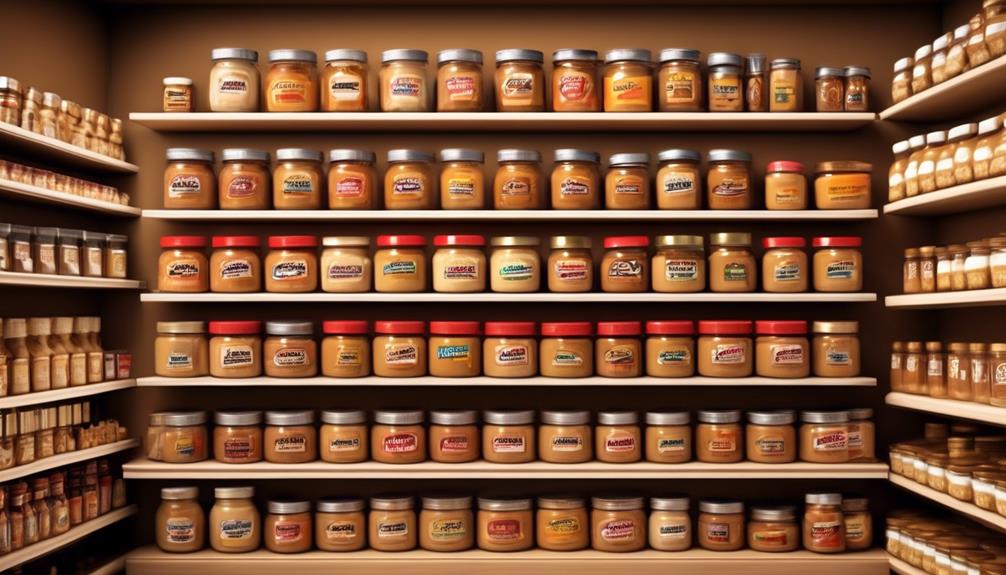
The high demand for peanut butter, driven by its popularity among health and fitness enthusiasts, significantly influences its market pricing. As the demand for peanut butter rises, so does its price. This increase in demand has a direct impact on the cost of peanut butter, driving it up as suppliers and producers seek to capitalize on the market trend.
This is evident in the current pricing, where peanut butter prices have risen by several cents per unit due to the surge in demand. The market demand for peanut butter not only affects its retail cost but also influences various factors contributing to its pricing, such as production, marketing, and distribution.
Additionally, the competitive nature of the market further propels the pricing of peanut butter, as brands invest heavily in marketing to differentiate themselves, passing on these costs to consumers. Moreover, limited availability in certain regions due to imports results in higher transportation and importation costs, further elevating the price of peanut butter.
Therefore, the influence of market demand plays a pivotal role in determining the price of peanut butter, affecting consumers' purchasing power and consumption patterns.
Impact of Branding on Price

When considering the impact of branding on the price of peanut butter, it's crucial to analyze the relationship between brand reputation and pricing.
Packaging plays a significant role in shaping consumers' perceived value of the product, which directly influences pricing strategies.
Additionally, the influence of advertising on consumer perception and pricing strategy can't be overlooked.
Brand Reputation and Price
Brand reputation significantly influences the pricing of peanut butter. Market-dominating brands like J.M. Smucker Co. are able to command higher prices due to their strong brand recognition and reputation. This is because their brand reputation gives consumers the perception of quality and reliability, allowing them to justify paying a premium price. The cost of marketing efforts, including sophisticated branding and organic credentials, is passed on to consumers, further impacting the price of peanut butter.
However, for consumers looking to avoid paying premium prices associated with fancy branding, store brands or budget options offer a more affordable alternative. These brands often have lower marketing costs, allowing them to offer peanut butter at a lower price point.
In addition to brand reputation, there are other factors that contribute to the overall price of peanut butter. The cost of ensuring peanuts are stored correctly, transportation and importation costs, and the manufacturing process all play a role in determining the final price. These costs are influenced by brand reputation and the associated production and handling costs.
Even within leading brands like Jif and Skippy, there are different pricing strategies. Wholesale clubs, for example, often offer competitive prices for both generic and name brand peanut butter. This illustrates the impact of brand reputation on pricing within the market.
Packaging and Perceived Value
Analyzing the impact of packaging on perceived value reveals the intricate relationship between branding and pricing in the peanut butter market.
- Packaging creates a visual and psychological connection, influencing consumers' perception of quality and value.
- Branding and packaging convey a story and lifestyle, enticing consumers to associate higher value with certain brands.
- Innovative and sustainable packaging designs can elevate the perceived value, justifying premium pricing for peanut butter products.
The packaging of peanut butter plays a pivotal role in shaping consumers' perception of its value. It serves as a tangible representation of the brand and its quality, influencing purchasing decisions. As consumers, we're drawn to packaging that communicates quality and aligns with our values, ultimately impacting the price we're willing to pay for peanut butter.
Advertising and Pricing Strategy
The impact of packaging on perceived value in the peanut butter market underscores the significance of advertising and branding efforts in shaping pricing strategies for different brands.
As companies invest in marketing to differentiate themselves and appeal to health-conscious consumers, these efforts significantly influence the pricing of peanut butter. The costs associated with marketing and branding are ultimately passed on to the buyers, contributing to the overall price of peanut butter. This phenomenon makes store brands or budget options an attractive cost-saving alternative for price-conscious consumers.
Additionally, the effective communication of product benefits and unique selling propositions through advertising can justify premium pricing for certain brands. Therefore, advertising and branding play a pivotal role in determining the perceived value of peanut butter, enabling companies to implement diverse pricing strategies to cater to varying consumer segments and preferences.
Cost of Peanuts Storage

Proper storage and transportation of peanuts significantly impact their quality and directly influence the pricing of peanut butter. The cost of ensuring peanuts are stored correctly is reflected in the pricing of peanut butter. Careful handling and storage are necessary to maintain the quality of peanuts. The high fat content of peanuts makes them difficult to store, requiring specific conditions to prevent spoilage.
The proper storage and transportation of peanuts incur additional costs for manufacturers. Incorrectly stored peanuts develop a chemical-like smell and taste bitter or sour, making them unsuitable for peanut butter production. These factors emphasize the importance of investing in adequate storage facilities and transportation methods to maintain the integrity of the peanuts used in peanut butter production.
The cost of peanuts storage is a crucial aspect that directly impacts the overall price of peanut butter. Manufacturers must bear the expenses associated with maintaining optimal storage conditions to ensure the peanuts' quality, which inevitably influences the final pricing of peanut butter for consumers.
Import Challenges for Peanut Butter

Importing peanut butter from countries with limited peanut cultivation presents significant challenges, impacting transportation costs and availability. Limited peanut cultivation in certain countries leads to a heavy reliance on imports, resulting in increased transportation and importation costs. Additionally, importing peanut butter from countries with different growing conditions can lead to higher prices due to limited availability and increased demand. This directly affects the price and accessibility of peanut butter in the United States, making it challenging for some regions to obtain at a reasonable cost.
Expats living abroad often face difficulties in obtaining peanut butter due to limited availability and higher costs of imported peanut butter. As a result, they often rely on friends and family to bring peanut butter when visiting. The availability and demand for peanut butter in different countries further complicate the import challenges, ultimately leading to increased prices for consumers. The additional expenses incurred in the transportation and importation processes contribute to the overall price of peanut butter in the market.
Manufacturing Process Costs
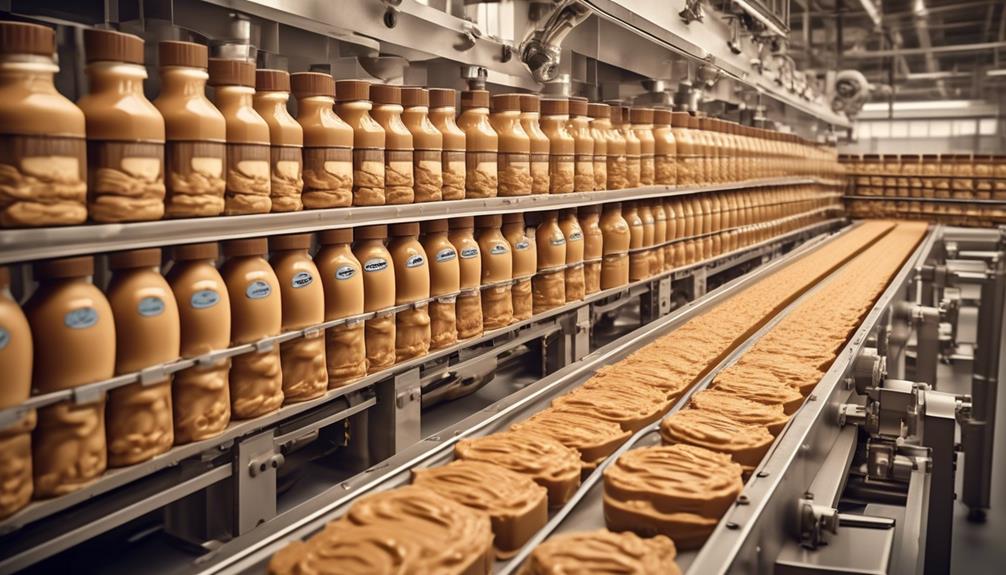
The manufacturing process costs of peanut butter are a crucial aspect of pricing analysis.
Ingredient sourcing and packaging expenses play a significant role in determining the overall manufacturing costs.
We must carefully examine these specific points to understand the impact on the pricing of peanut butter.
Ingredient Sourcing
Investing in equipment, research, and development to meet consumer demands for quality and variety adds to the manufacturing process costs of peanut butter. The sourcing of raw nuts like peanuts significantly impacts these costs. Factors such as crop yield, careful handling, and storage needs influence the overall manufacturing expenses.
Additionally, the cost of transporting and importing peanuts for peanut butter production contributes to the total manufacturing process costs. Furthermore, the cost of raw materials and production processes varies across different nut butters, with factors like the cost of growing and processing peanuts versus almonds contributing to overall price differences.
Understanding these intricacies illuminates the multifaceted nature of peanut butter and nut butter pricing, providing insight into the complexities involved in the ingredient sourcing process.
Packaging Expenses
Careful consideration of packaging expenses is crucial for manufacturers to maintain product quality and appeal to consumers while managing production costs.
Packaging expenses encompass the costs associated with designing, manufacturing, and labeling the containers used to store and sell products like peanut butter and jelly. These costs include materials such as glass, plastic, or metal, as well as the labor and machinery needed for the packaging process.
Additionally, packaging expenses involve the development of attractive and informative labels to appeal to consumers and comply with regulations.
Efficient and sustainable packaging solutions can help minimize expenses and reduce environmental impact, benefitting both the manufacturer and the consumer.
When it comes to a jar of peanut butter or homemade peanut butter, smart packaging decisions can significantly impact the overall cost and consumer perception.
Homemade Vs. Store-Bought Peanut Butter

When considering the decision between homemade and store-bought peanut butter, consumers can weigh the advantages and disadvantages of each option to make an informed choice.
Homemade peanut butter allows for control over ingredients and customization, offering a healthier alternative to store-bought options that may contain added sugars and preservatives. On the other hand, store-bought peanut butter provides convenience and a variety of flavors, catering to diverse consumer preferences.
Additionally, homemade peanut butter can be less expensive, especially when using bulk nuts, compared to premium store-bought options, contributing to cost savings without compromising quality.
In weighing the decision between homemade and store-bought peanut butter, consumers should consider their priorities, whether it's the desire for healthier ingredients, flavor variety, or cost-effectiveness. These factors can guide individuals towards the option that best aligns with their preferences and values.
Frequently Asked Questions
Why Is Peanut Butter so Expensive Now?
Peanut butter is so expensive now due to a combination of factors.
Sweltering temperatures and drought have led to a decreased peanut crop, causing a shortage.
The dominant market player plans to raise prices by 30% due to the shortage.
High demand, sophisticated branding, and marketing efforts also contribute to the increased cost.
Additionally, the cost of storing, handling peanuts, and the manufacturing process adds to the overall price.
Why Is There a Peanut Butter Shortage?
The peanut butter shortage stems from a 13% smaller peanut crop caused by extreme heat and parched soil in the Peanut Belt states.
This shortage has prompted major players like J.M. Smucker Co. to forecast a 30% price increase in November.
High demand, especially from health and fitness enthusiasts, has further driven up costs.
Additionally, the branding and marketing efforts of companies, as well as the costs of storing and handling peanuts, all contribute to the pricing of peanut butter.
Why Are Peanuts so Expensive 2023?
Peanuts are expensive in 2023 due to a combination of factors. Crop damage from extreme weather conditions has reduced harvest sizes, leading to a scarcity of peanuts. Major companies dominating the market have driven up prices. High demand, influenced by popularity and health benefits, has also played a role.
Additionally, costs related to branding, marketing, and production processes contribute to the expensive nature of peanuts.
Why Is Jif so Expensive?
We believe Jif is expensive due to multiple factors.
The 13% decrease in this year's peanut crop, sweltering temperatures, and parched soil in Peanut Belt states like Georgia and Texas have impacted production.
J.M. Smucker Co., dominating 45% of the peanut butter market, expects to raise prices by 30% in November.
Additionally, high demand, marketing efforts, and the cost of storing and handling peanuts contribute to the overall expense of Jif.
Conclusion
In conclusion, the price of peanut butter is influenced by a complex interplay of factors, much like a symphony orchestra with each instrument playing a crucial role in creating the final masterpiece.
From the cost of peanuts to the impact of market demand and branding, every component contributes to the overall price.
Understanding these factors can help consumers make informed decisions and appreciate the value behind their favorite spread.
From sneaky childhood butter licks to penning some of our most popular articles, Jamie’s journey with butter has been lifelong. His culinary background gives him a unique perspective, allowing him to craft mouthwatering articles that educate and tantalize equally. Jamie’s travel adventures revolve around finding the world’s best buttery treats when he isn’t writing.
Peanut Butter
Why Is Peanut Butter a Good Source of Protein?

Peanut butter, like a reliable friend, has always been a staple in our pantry. There's something about its creamy texture and nutty flavor that makes it a versatile and beloved addition to many dishes.
But what exactly makes peanut butter so good? Well, there are several reasons why this humble spread has earned its reputation as a nutritional powerhouse. From its protein content to its heart-healthy fats, there's a lot to unpack when it comes to the benefits of peanut butter.
Key Takeaways
- Peanut butter is a nutritious spread that offers a wide range of health benefits.
- It is a good source of protein, essential amino acids, healthy fats, and essential nutrients like vitamin E, magnesium, and potassium.
- Peanut butter contributes to daily fiber intake, aids in digestion, and promotes a feeling of fullness.
- It contains antioxidants that protect cells from oxidative stress and may lower the risk of cancer and heart disease.
Nutritional Benefits
Peanut butter offers a plethora of nutritional benefits, making it a valuable addition to a balanced diet. When considering the health aspect, it's important to select peanut butter brands that prioritize natural ingredients without added sugars or hydrogenated oils.
The inclusion of peanuts, a heart-healthy nut, provides a good source of protein and essential amino acids crucial for muscle repair and growth. Moreover, the healthy fats present in peanut butter, such as monounsaturated and polyunsaturated fats, play a pivotal role in supporting heart health and lowering bad cholesterol levels, ultimately reducing the risk of heart disease.
Additionally, the abundance of essential nutrients like vitamin E, magnesium, and potassium in peanut butter contributes to overall health and wellness. The high fiber content not only aids in digestion but also promotes a feeling of fullness, which can contribute to weight management. However, it's vital to consume peanut butter in moderate amounts due to its calorie density.
Healthful Fats and Proteins
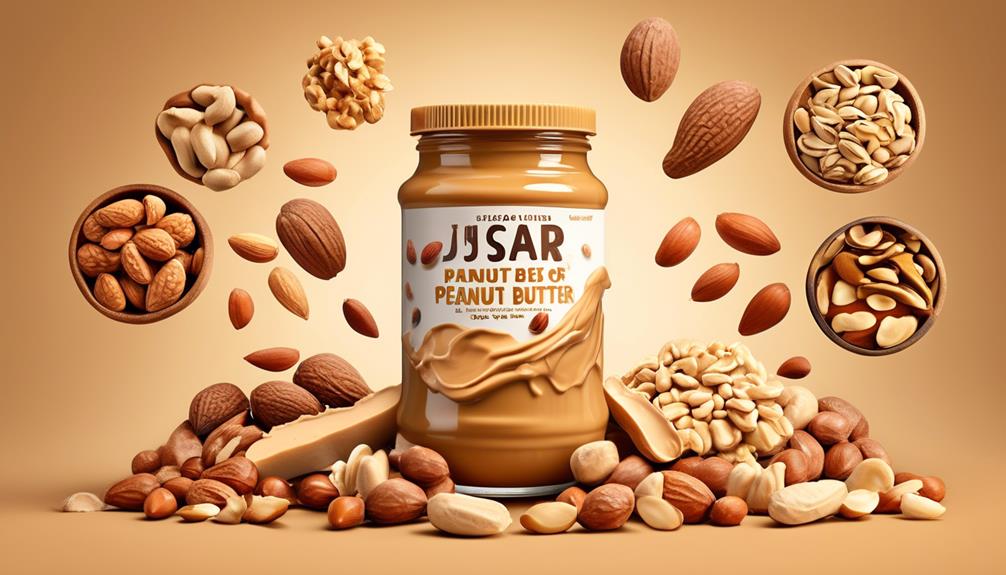
Rich in essential fatty acids, antioxidants, and monounsaturated fats, peanut butter is a valuable source of healthful nutrients that contribute to heart health and overall well-being. The fats in peanut butter include both omega-6 fatty acids and monounsaturated fats, which are beneficial for heart health. While it's high in fat, the majority is monounsaturated fat, which can help reduce the risk of heart disease when consumed as part of a balanced diet.
Additionally, the protein content in peanut butter is substantial, making it a satisfying and filling option. Protein not only aids in muscle repair and growth but can also help control blood sugar levels and appetite. By choosing natural or organic peanut butter without added sugars and trans fats, individuals can maximize the health benefits, including essential vitamins and minerals.
Incorporating peanut butter into meals and snacks can offer a delicious way to consume healthful fats and protein, contributing to overall well-being.
Vitamin and Mineral Content
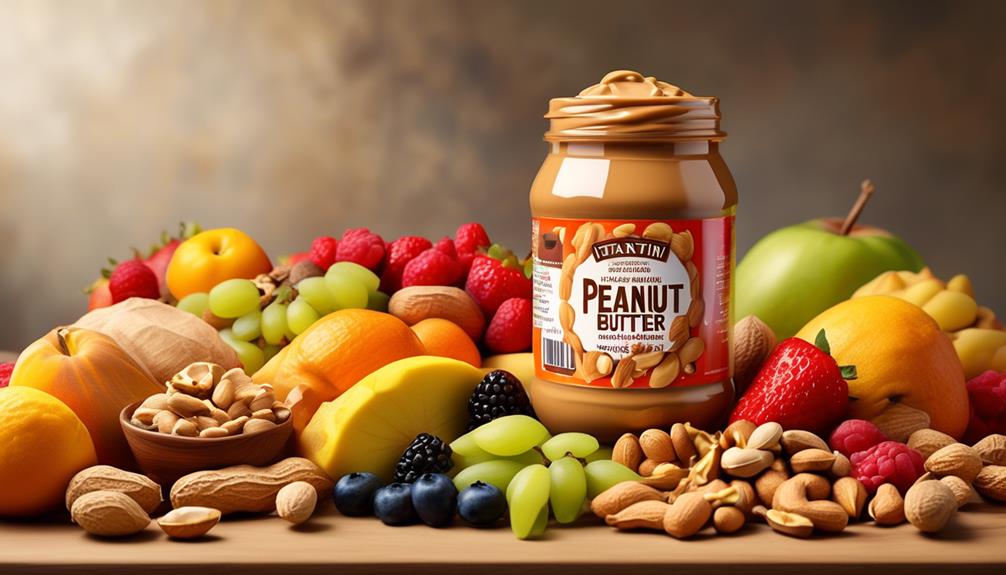
Peanut butter is a nutrient-rich spread that offers essential vitamins and minerals.
A 2-tablespoon serving provides approximately 2 mg of vitamin E, 49 mg of magnesium, and 208 mg of potassium.
Additionally, it contains niacin and small amounts of zinc, contributing to energy production, metabolism, immune function, and wound healing.
Nutrient-Rich Spread
Containing a wealth of essential vitamins and minerals such as vitamin E, magnesium, and potassium, peanut butter is a nutrient-rich spread that contributes to a balanced diet and supports overall wellness.
Peanut butter is a good source of protein, essential amino acids, and healthy fats, making it beneficial for muscle repair, immune system function, and weight loss.
The heart-healthy monounsaturated and omega-6 fatty acids in peanut butter may lower the risk of developing heart disease.
Moreover, the vitamin E content in peanut butter supports skin and hair health, while the magnesium and potassium help regulate blood sugar levels.
Incorporating natural or organic peanut butter into a balanced diet can provide these essential nutrients and promote overall health.
It's important to be mindful of portion sizes and choose natural varieties to maximize the nutrient benefits of peanut butter.
Essential Vitamins and Minerals
Packed with a plethora of vital nutrients, peanut butter serves as a substantial source of essential vitamins and minerals necessary for maintaining overall health and well-being. It contains protein, fiber, niacin, magnesium, phosphorous, zinc, and vitamin B-6, contributing to a healthful diet. These nutrients support nerve function, insulin sensitivity, and aid in maintaining a healthy weight.
The nutrient profile of peanut butter also includes monounsaturated and polyunsaturated fatty acids, which can reduce the risk of heart disease by lowering bad cholesterol levels. Additionally, the rich antioxidants and essential fatty acids in peanut butter contribute to cell repair, skin health, and protection against oxidative stress.
Despite these benefits, it's crucial to consume peanut butter in moderation due to its high calorie, saturated fat, and sodium content.
Dietary Fiber Contribution
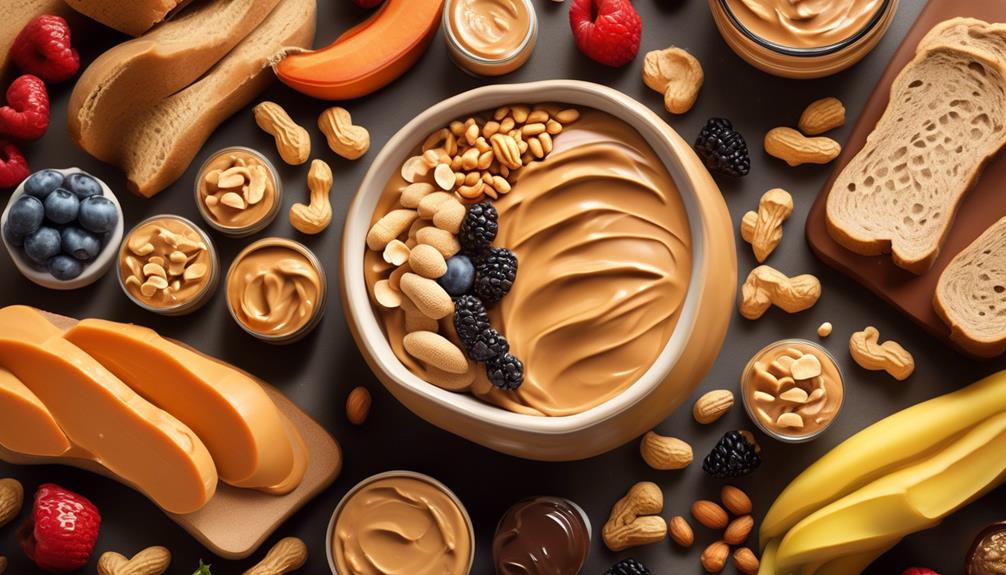
With approximately 2 grams of dietary fiber in a 2-tablespoon serving, peanut butter is a significant contributor to daily fiber intake, promoting digestive health and supporting overall well-being. Peanut butter's high fiber content aids in digestion, promotes a feeling of fullness, and supports the growth of healthy gut bacteria. It helps manage blood sugar levels and lower cholesterol, potentially lowering the risk of heart disease. Including peanut butter in the diet not only adds to the daily fiber intake but also contributes to overall digestive health and regularity. Choosing natural or organic peanut butter options can maximize the dietary fiber contribution while avoiding added sugars and unhealthy fats.
- Peanut butter's high fiber content aids in digestion and promotes a feeling of fullness.
- It supports the growth of healthy gut bacteria, contributing to overall digestive health.
- The dietary fiber in peanut butter can help manage blood sugar levels and lower cholesterol, potentially lowering the risk of heart disease.
- Choosing natural or organic peanut butter options maximizes the dietary fiber contribution while avoiding added sugars and unhealthy fats.
Antioxidant Properties
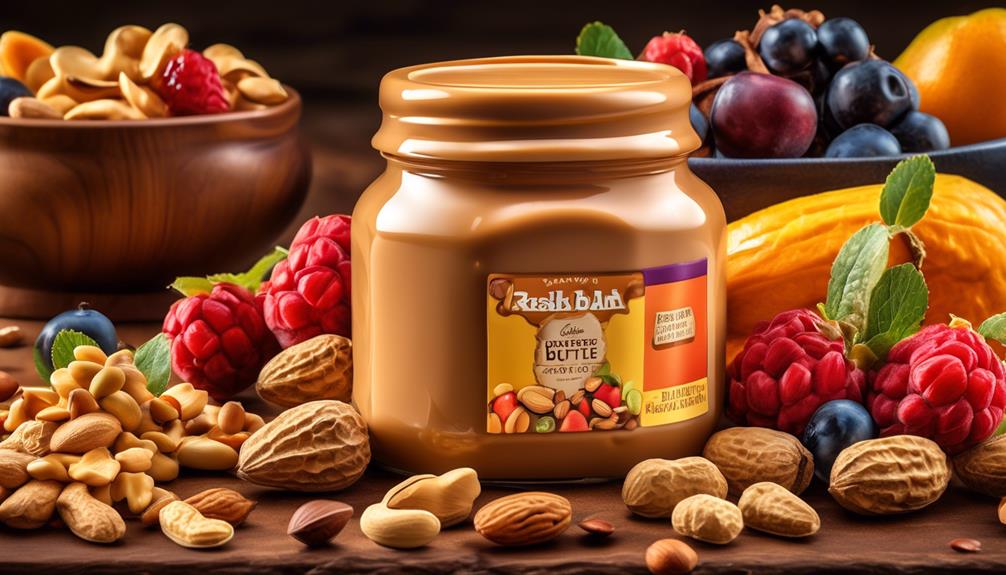
The antioxidant properties of peanut butter are worth exploring, as they play a significant role in promoting overall health.
The presence of antioxidants, such as vitamin E and resveratrol, in peanut butter may contribute to reducing the risk of chronic diseases.
These antioxidants help protect the body's cells from free radical damage, offering potential benefits in disease prevention and free radical defense.
Health Benefits
Containing antioxidants such as vitamin E and p-coumaric acid, peanut butter plays a significant role in combating oxidative stress and protecting cells from damage, thereby contributing to reducing the risk of chronic diseases such as heart disease and certain types of cancer.
Regular consumption of peanut butter is a good option for promoting overall health, as its antioxidant properties support the body's defense against free radicals and inflammation. This may help reduce your risk of heart disease and certain types of cancer.
Additionally, a high intake of peanut butter may contribute to a lower risk of chronic diseases. It's important to note that while peanut butter is healthy due to its antioxidant content, it's high in calories, so moderation is key.
Always consult a healthcare professional for diagnosis or treatment.
Disease Prevention
Taking into account its potent antioxidant properties, peanut butter plays a crucial role in preventing diseases and promoting overall health.
Studies have shown that peanut butter, with its high antioxidant content, can help prevent oxidative stress and reduce the risk of chronic diseases. The antioxidants in peanut butter contribute to maintaining good cholesterol levels, blood sugar levels, and blood pressure, making individuals less likely to develop heart disease.
Furthermore, the presence of antioxidants in peanut butter may lower the risk of cancer and promote cell repair. Incorporating peanut butter into a balanced diet can help protect against oxidative damage and reduce the risk of developing type 2 diabetes.
Free Radical Defense
Boasting potent antioxidant properties, peanut butter actively defends the body against free radicals, mitigating the risk of cellular damage and chronic diseases. The antioxidants in peanut butter, such as vitamin E and flavonoids, help neutralize free radicals, protecting cells and tissues from oxidative stress. Consuming peanut butter with antioxidant properties may contribute to lower risks of cancer, heart disease, and other chronic conditions by combating free radicals.
Additionally, these antioxidants promote cell repair and enhance the body's defense against oxidative damage, ultimately boosting overall health and well-being. Including peanut butter with antioxidant properties in our diet supports the body's natural defense system, contributing to long-term health.
With its high content of oleic acid and vitamin B, peanuts play a crucial role in safeguarding our health and well-being.
Satiety and Energy Boost
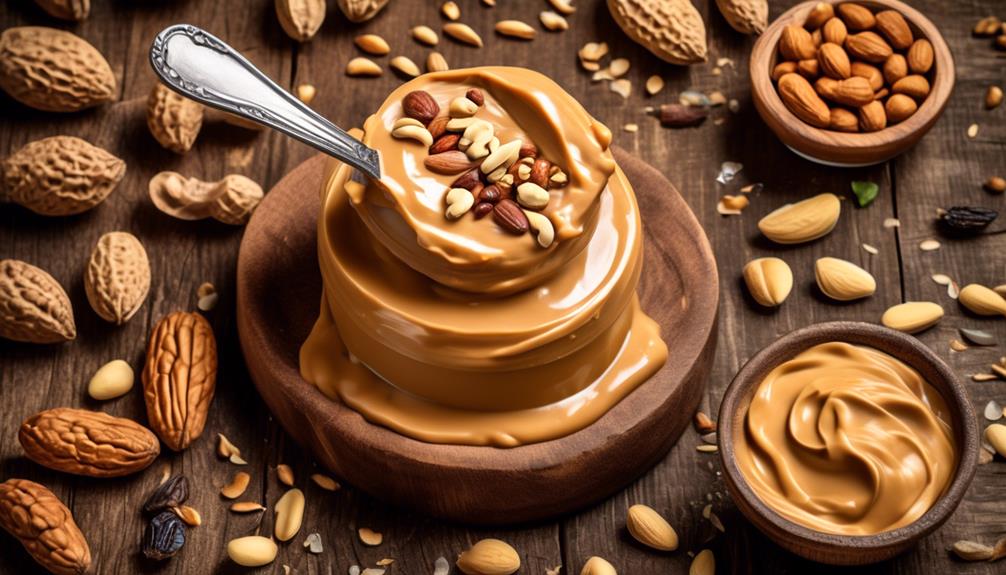
Peanut butter provides a sustained feeling of fullness and a reliable source of energy due to its high protein and healthy fat content. The protein in peanut butter helps to regulate appetite and increase satiety, which can aid in weight management. Additionally, the healthy fats in peanut butter provide a slow-burning source of energy, which can help maintain stable blood sugar levels and prevent energy crashes. This combination of protein and healthy fats makes peanut butter an excellent choice for a satisfying snack or addition to meals.
In terms of health, peanut butter is relatively high in calories, so portion control is important, especially for those watching their calorie intake. However, the fats in peanut butter are predominantly heart-healthy monounsaturated and polyunsaturated fats, which can have a positive impact on cholesterol levels and overall heart health. Peanuts, the main ingredient in peanut butter, also contain various nutrients and antioxidants that contribute to its health benefits.
It's important to note that while peanut butter has numerous health benefits, it's crucial to choose natural varieties without added sugars and excessive salt to minimize potential risks associated with processed foods.
Frequently Asked Questions
What Are the Benefits of Eating Peanut Butter?
Eating peanut butter offers numerous benefits.
It's a rich protein source, aiding muscle repair and growth.
The healthy fats support heart health, lowering the risk of heart disease.
Packed with vitamins and minerals, it contributes to overall well-being.
Its protein-fiber combo aids weight management and appetite control.
Moreover, it helps with blood sugar management, reducing the risk of type 2 diabetes.
Including it in a balanced diet promotes overall health and wellness.
Why Is Peanut Butter so Good?
Peanut butter is good due to its rich protein, healthy fats, and essential nutrients. It's beneficial for heart health, appetite control, and weight management.
Additionally, its versatility makes it a convenient, nutritious option for various recipes and snacks.
When opting for peanut butter, choosing natural or organic varieties without added sugars, oils, or trans fats maximizes its health benefits.
Is Peanut Butter OK to Eat Everyday?
Oh, peanut butter? Absolutely! We make it a daily staple. Packed with protein, healthy fats, and essential nutrients, it's a great addition to our diet.
Research suggests it can improve heart health, regulate blood sugar, and reduce the risk of certain diseases. Just be mindful of portion sizes and opt for natural, sugar-free options.
It's all about balance and moderation.
Why Is a Spoonful of Peanut Butter Good for You?
A spoonful of peanut butter is good for us because it provides a healthy dose of protein, fiber, and essential nutrients like magnesium, phosphorus, and vitamin B-6. This combination supports heart health, helps with appetite control, and can aid in weight management.
Additionally, peanut butter can help regulate blood sugar levels, making it a suitable option for individuals with type 2 diabetes. Its versatility also allows for easy incorporation into various dishes and snacks.
Conclusion
In conclusion, peanut butter offers a wealth of nutritional benefits. It is rich in protein, which is essential for muscle repair and growth. Peanut butter also contains heart-healthy monounsaturated fats. These fats can help improve cholesterol levels and lower the risk of heart disease.
Additionally, peanut butter is a good source of fiber, vitamins, and minerals. The fiber helps with digestion and can promote a feeling of fullness. The vitamins and minerals in peanut butter contribute to overall health and well-being.
Another benefit of peanut butter is its antioxidant properties. Antioxidants help protect the body against damage from harmful free radicals. This added protection can have a positive impact on long-term health.
It is important to note that while peanut butter is nutritious, it should be consumed in moderation. It is high in calories, so excessive consumption can lead to weight gain. However, incorporating peanut butter into a balanced diet can provide a satisfying and energy-boosting addition.
So, next time you enjoy that creamy peanut butter on your toast, remember the array of benefits it brings to your health.
From sneaky childhood butter licks to penning some of our most popular articles, Jamie’s journey with butter has been lifelong. His culinary background gives him a unique perspective, allowing him to craft mouthwatering articles that educate and tantalize equally. Jamie’s travel adventures revolve around finding the world’s best buttery treats when he isn’t writing.
-

 Recipes & Culinary Uses2 months ago
Recipes & Culinary Uses2 months agoHow Many Sticks of Butter Equals a Pound: A Handy Guide
-

 Shopping Guides1 month ago
Shopping Guides1 month agoWhere to Buy Raw Butter
-

 Recipes & Culinary Uses4 weeks ago
Recipes & Culinary Uses4 weeks agoMake Homemade Butter from Milk at Home
-

 Recipes & Culinary Uses4 weeks ago
Recipes & Culinary Uses4 weeks agoMake Creamy Butter From Buttermilk
-

 Butter Tips and Tricks3 months ago
Butter Tips and Tricks3 months agoHow Long Can You Use Butter After the Expiration Date?
-

 Recipes & Culinary Uses2 months ago
Recipes & Culinary Uses2 months agoMake Your Own Homemade Spray Butter
-

 Butter Tips and Tricks3 months ago
Butter Tips and Tricks3 months agoHow Much Butter to Use Instead of 1/3 Cup Oil
-

 Butter Tips and Tricks3 months ago
Butter Tips and Tricks3 months agoHow Many Calories Are in a Stick of Butter: A Comprehensive Guide




















